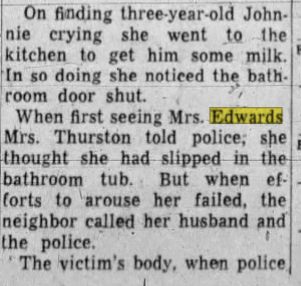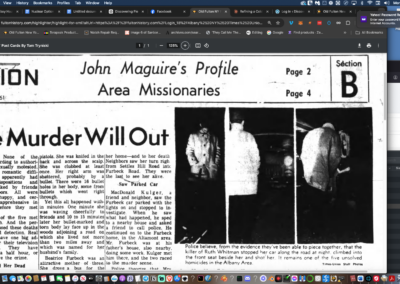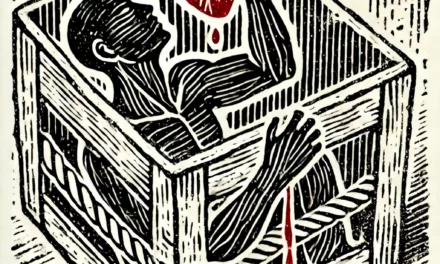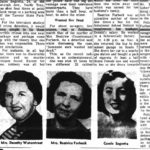FOR IMMEDIATE RELEASE
Two Family Members of Rosetta Edward’s 1957 Cold Case Murder Investigation Come Forward With New Evidence and a New Theory
Contact: Edmund J. Janas, II
Phone: 413.626.4777
Email: info@discoveringpie.com
SUMMARY
The family of Rosetta Westbrook Edwards, a 22-year-old mother of four found strangled in her Albany basement apartment in 1957, is taking renewed action to seek justice in this decades-old cold case. Newly uncovered evidence, including suppressed signs of forced entry, overheard accounts of a struggle, and inconsistencies in initial media coverage, has come to light.
Family testimony and a reexamination of the original suspect have revealed potential connections to other unsolved cases. Edmund Janas, Edwards’ nephew, is producing a documentary and companion book on the murder, aiming to bring public attention to the injustice that has haunted the family for decades.
The family and community deserve answers, and they are urging the Albany police to reexamine the case and finally bring closure and justice for Rosetta.
VICTIM BACKGROUND
Rosetta Westbrook Edwards, described as demure and well-liked in the community
Eldest daughter of a migrant farming family, known for her strength despite her petite frame
Moved to Albany with her three children after her husband’s death
Sister of Deloris Westbrook Berry, who is actively assisting in the investigation
CASE DETAILS
Date: November 3, 1957
Location: Victim’s apartment at 99 Orange St., Albany, NY
Key Evidence Suppressed at the Time:
Signs of Forced Entry: Contradicted by media reports that downplayed or omitted this detail.
Evidence of a Struggle: Found at the scene but not emphasized in initial media coverage.
Children’s Safety Overlooked: The vulnerability of Edwards’ children in the apartment was not addressed.
Potential Oversight in Suspect Interviews: Family accounts suggest Mallory had scratches on his face after the murder—a possible sign of a struggle. Despite this, it is believed Mallory was interviewed and cleared, raising further suspicions.
These contradictions are only now surfacing because the family, trusting that the police were thoroughly investigating, initially withheld key details from the public. However, the family never received follow-up from the authorities and eventually had to move forward with their lives.
PERSON OF INTEREST: WESLEY MALLORY
Wesley Mallory, also known as Willie Thomas, escaped from an Alabama chain gang in 1946, where he was serving a 100-year sentence for a robbery committed as a teenager. After his escape, he lived in Albany for 11 years under an assumed name, working at Allegheny Ludlum Steel Company.
He was the stepfather of Rosetta Edwards’ brother-in-law, a connection that may have made it difficult for individuals with information to come forward. Deloris Westbrook Berry was 9 when her sister was murdered. By age 10, she had met Mallory and felt a deep unease around him—a feeling that would only deepen as the family tragedy unfolded. Years later, in California, Mallory’s wife, Irene, reported to Deloris who had recently located to Los Angeles, that she knew of police questioning regarding Edwards’ murder, suggesting possible suspicions about her husband’s involvement.
MEDIA FRAMING AND POLITICAL INTERESTS
Media coverage of Wesley Mallory during the Cold War era often downplayed the brutality of his 1934 crime, presenting it as mere ‘robbery’ or ‘car theft.’ This portrayal, coupled with a negative framing of civil rights groups, aligned with the era’s anti-communist sentiments and potentially swayed both public perception and investigative priorities.
Despite the brutality of Mallory’s 1934 crime—grabbing a woman by the throat until she lost consciousness and beating her with “knotwood,” causing a possible fractured skull and broken finger—national coverage omitted these facts, presenting a sanitized version. Although Mallory was granted clemency in 1951, six years before Rosetta’s murder, the parallels between his earlier assault and Rosetta’s strangulation have only recently surfaced. These connections, drawn from historical articles and documents, raise critical questions about the completeness of both the reporting and the original investigation. The family is now urging the police to reexamine media portrayals and gaps in the case.
Mallory’s portrayal in the press often painted him as a misunderstood figure, refusing aid from civil rights organizations despite his second-grade education. Inconsistent accounts of his age—sometimes listed as 14, other times as 16—also raise questions about the accuracy of media coverage. According to 1940 Atmore Prison Farm census records, Mallory was listed as 22, further complicating the narrative. Regardless of his exact age, the severity of his 100-year sentence as a teenager raises doubts about the fairness of his punishment.
A notable concern is Police Chief John P. Tuffey’s dual involvement: not only was he a key figure in Mallory’s 1951 extradition trial, but he also led the investigation into Edwards’ murder. Tuffey’s role in delivering clemency papers from Governor Dewey during Mallory’s trial, combined with his active Civil Defense background and anti-communist stance, casts a shadow on the impartiality of both cases. The media’s framing—carrying biases against unions, communism, and civil rights organizations like the NAACP—contributed to a distorted public narrative and may have influenced investigative decisions.
INVESTIGATION CONCERNS
Detective John P. Tuffey’s Dual Role: Both Detective and Police Chief, Tuffey came out of retirement specifically for the Edwards case. Despite his history of solving high-profile cases, he was “stumped” by Edwards’ murder.
Civil Defense Background: As a Civil Defense organizer, Tuffey’s anti-communist stance aligned with the era’s propaganda during the Korean War.
Overlap in Cases: Tuffey’s direct involvement in Mallory’s 1951 extradition trial raises questions about impartiality in the subsequent Edwards investigation.
INVESTIGATION INCONSISTENCIES
Conflicting Evidence Reports: Discrepancies in accounts regarding visible neck bruising and evidence of a struggle were noted but not properly followed up.
Missing Coroner’s Report & Dismissed Evidence: The family could not locate Dr. Ronan Champion’s coroner’s report despite extensive efforts. Key evidence provided by the family was dismissed, including information about a letter from Rosetta Edwards about a harassing bus driver that was sent to her brother who was stationed in Germany.
RELATED CASES
Three similar murders between 1957-1961.
All victims were women; Edwards was the only African American.
No sexual assault or robbery indicated in any cases; extreme rage noted.
POLITICAL CONTEXT
Korean War era; heightened fear of communism.
Civil rights tensions affecting law enforcement.
Mallory case used as propaganda for North-South cooperation.
NEW INVESTIGATION FOCUS
The family is urgently raising critical questions they believe should have been addressed during the original investigation. These include examining access to apartment keys, investigating a bus driver, and exploring connections to similar murders in the area.
QUOTES
“My sister, Rosetta Westbrook Edwards, was 22 years old, a dutiful mother of four, and kind to all. Her murderer has never been identified or caught. Over the years, I have witnessed the trauma it has caused my family. My nephew has chosen to pursue this endeavor of getting answers about my sister’s murder to hopefully give those of us left some answers.”
— Deloris Westbrook Berry
“I never knew my Aunt Rosetta, ‘Pie,’ who died 13 years before my birth, yet her absence shaped our family profoundly. Conversations with my aunt this summer revealed discrepancies that sparked this journey for justice. For over 65 years, Rosetta’s murder has cast a shadow over our family, and we want to right the wrongs of the past so her voice is finally heard.”
— Edmund J. Janas, II, Discovering Pie
CALL TO ACTION
Rosetta deserves justice, and even the smallest detail could be the key to uncovering the truth. If you have any information, please contact the Albany police or email
info@DiscoveringPie.com to help ensure Rosetta’s story is heard.
CITATIONS
Rosetta Edwards Murder Case
Transcript-Telegram (Holyoke, Massachusetts) – Nov 7, 1957
Albany Newspaper – Nov 4, 1957
Holyoke Newspaper – 1957
Wesley Mallory / Willie Thomas Case
Democrat and Chronicle (Rochester, NY) – Nov 29, 1951
The Knickerbocker News (Albany, NY) – Nov 5, 1951
Oswego Palladium-Times – Nov 28, 1951
Detective John P. Tuffey
Albany, NY Memories Forum (Online) – Sep 29, 2024
General Notes & Fulton History Archive
Multiple articles covering background, details surrounding the murder, and research surrounding Detective Tuffey. For full historical context and additional references, see Fulton History Archive at https://fultonhistory.com/Fulton.html
The Family will be meeting with Commander Chris Cornel of the Criminal Investigation Unit on Monday October 7th at 11am, in the hope of getting answers and police cooperation in this matter. We have reached out to the NAACP for comment or assistance and have yet to get a response. For case updates, and to support the family’s pursuit of truth and justice, visit https://DiscoveringPie.com
Update. Feeling like our meeting was a big okeedoke. We gave information we had, but were given not one piece of paperwork or evidence on my Aunts murder. We hope they keep their word and give us paperwork, but if past is prologue, they won’t and it’s my humble opinion that the powers that were wanted this case, and possibly the others, forever burried.




























